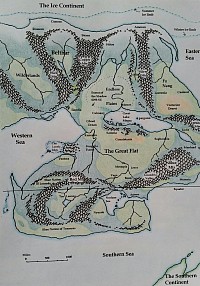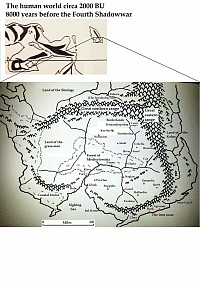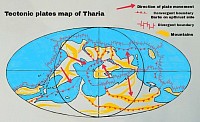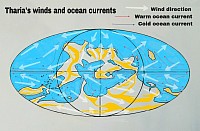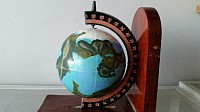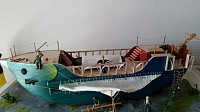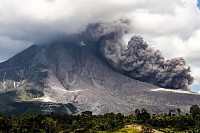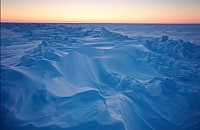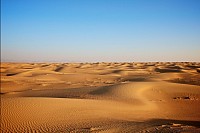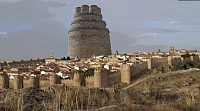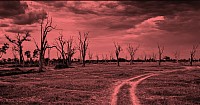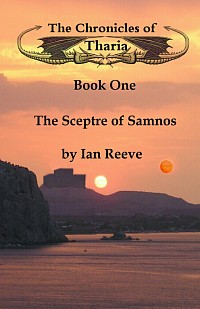Some maps and other artwork.
This is the main map for the books, showing the places where most of the action takes place. This continent is called Amafryka and, along with a smaller island continent called Garon, is the only part of the planet Tharia where civilised human life is to be found.
This shows the southern half of the island continent of Garon. The map shows the area as it was eight thousand years ago, since this is the era in which this part of the story took place. At this time, this was the only place where civilised human life could be found. It was only in later centuries that the first colonists crossed the ocean to settle on the continent of Amafryka.
This is a map of the tectonic plates of the planet Tharia, showing plate boundaries and whether they're converging or diverging. It's not a thing of beauty, I know, and I might do a better one one day, but it's good enough to allow me to predict where earthquakes and volcanos are likely to occur and where evidence of archaic civilisations are most likely to be found. I had to make a couple of changes when the map was complete, such as when I realised that the world's oldest human city was in a place that was unlikely to have remained intact for fourteen thousand years.
This map shows the major winds and ocean currents of Tharia, which allows me to predict which areas receive most and least rainfall, where hurricanes are likely to strike, and so on. One of the most interesting discoveries I made while making this map was the series of vortices of warm water created as ocean currents flow north past the island continent of Garon. These would allow sea creatures to survive much further north than would normally be the case, as the vortices slow the rate at which the water within them loses heat to the surrounding cold water. I imagine a unique ecosystem of sea creatures migrating south to the next vortex down as the one they live in eventually cools and dissipates. This sort of discovery is what I find most fascinating about world building. I feel as though I'm not so much creating a world as exploring it.
One of the most important differences between Tharia and Earth is that Tharia has a considerably thinner atmosphere. Air pressure at sea level on Tharia is about equal to that at an altitude of five thousand feet on Earth. This means that, while on Earth, winds can just blow across mountain ranges, being lifted so that they cool and lose their water as rain, on Tharia the highest mountain ranges form a much more serious barrier to the atmosphere, forcing them away from the paths they would prefer to take as a result of atmospheric convection cells and the planet's rotation.
I made this globe of the planet Tharia by painting over a globe of the planet Earth, which was one of a pair of bookends. Being able to see the oceans and continents in their true perspective helped me to visualise likely weather patterns and areas of tectonic activity caused by continental drift, very little of which made it into the books but which gave me a better feel for the planet.
I made a model of the Hummingbird, the flying scout ship that features in volume eight, The Flight of the Hummingbird. This diorama shows the ship landed for repairs. One crewman is making a new mast elevator strut while others, including the wizard Saturn, keep a lookout for danger. I made the model some years after writing the first draft of the book and making it, which involved drawing up a complete set of deck plans of the below decks area, figuring out where the rigging had to go etc helped me correct a few continuity errors and make the ship a bit more practical and believable.
I created this image using a basic smartphone photo editing app. I'm thinking of using it as the cover image for book two, Defenders of the Faith. It shows the view from one of the upper windows of Sen Camaris, an abandoned Agglemonian castle. The red sun is casting its ruddy glow across the landscape of southern Amafryka, while the light of the yellow sun, just below the horizon, is reflected from Thelia, the largest moon.
I found this image on the internet and it reminded me of the Red Mountains of southern Amafryka. This range is composed almost entirely of compacted volcanic ash and pumice spewed out from hundreds of active calderas, some more than twenty miles across. They form a plateau covering nearly a million square miles that has been eroded into ridges and valleys by the action of wind and rain and which is so treacherous, due to landslides and newly falling ash from eruptions, that no-one has ever crossed them on foot. The ash acts as an excellent fertiliser, though, and the forests and jungles flanking the mountains grow lush and green after each ashfall.
The first human explorers to reach the mountains named them the Ash Mountains, but the Old Garonian word for ash is very similar to the word for red and the mapmakers, whose only knowledge of mountains was of the flowing lava kind, assumed it was a spelling mistake on the part of the largely illiterate explorers. They've been known as the Red Mountains ever since.
Like Earth, Tharia has a north polar ocean that is covered with ice. Unlike Earth, this ice is at least ten million years old and has grown over a mile thick, so that it touches the sea bed in many places. It is not a single piece of ice, though, but is broken into several pieces that press and rub against each other as they're moved by ocean currents beneath them, creating their own version of plate tectonics with mountain ranges of ice being pushed up and shaken by icequakes.
Tharia has almost no axial tilt (less than two degrees), which means that at the poles the yellow sun barely rises above the horizon. This leads to temperatures in winter falling low enough for co2 to condense out of the atmosphere and fall as snow. When the dry ice sublimes in spring, it takes a few days for the co2 to mix properly with the atmosphere, especially if there is no wind. Co2 rich air hugs the ground as it moves south, therefore. and settles in low areas, displacing the oxygen and asphyxiating anyone it finds there. Fortunately, only a handful of hardy flook trappers ever go that far north. The co2 has usually dispersed harmlessly by the time it reaches inhabited latitudes.
The Great Southern Desert occupies the centre of the Southern Continent and, as far as is known, has never been visited by any of Tharia's four civilised races. It is known only from the scrying spells of wizards, and even they have only caught glimpses of its immensity and surprising variety.
The desert covers over six million square miles and is surrounded by mountains on all sides, which has prevented any rain from falling on it for over ten million years. As a result, the sands and rocks of the desert have become hyper-arid, which means that chemical reactions have created substances that cannot exist in the presence of even the tiniest amount of water. If water should somehow be transported there, for instance in the body, perspiration and breath of a hapless explorer, it would trigger the explosive hydration of these substances, resulting in the explorer being immediately burned to death by the violently exothermic reactions.
Life, including civilised life, did once occupy this region, though, in prehistoric times when it had a large freshwater lake in its centre, and occasionally, when winds blow the shifting sands away from one area or another, the eroded ruins of an impossibly ancient city built by one of Tharia's prehuman races, are revealed in the crystal ball of an astonished wizard.
This is an image I knocked up in a couple of hours with a free photo editing app. It's the city of Fort Battleaxe, a relatively young city that grew up around Battleaxe Tower, an ancient Agglemonian fortress. At three thousand years old it's as old as the pyramids and, like them, is built from huge blocks of stone that each required dozens of men to move. It's designed to take any amount of punishment that its enemies can throw at it, whether they be dragons, wizards or demons, and there's nothing better at taking punishment than vast amounts of solid stone.
When it was new it was much better looking, with a coating of white limestone and decorative carvings, but the centuries have worn this away, leaving the bare stone exposed. It's still as strong as ever, though, and has never fallen despite having seen many wars and having been occupied by three successive civilisations, all of which have been glad to have it defending its borders.
The Shadow is a huge area of supernatural darkness covering the centre of the continent of North Amafryka. It covers most of what used to be the kingdom of Agglemon and the vast, flat grasslands that were once the breadbasket of the continent. It first appeared five hundred years ago, during the bad years of the fall of the Agglemonian Empire, and is thought to have been caused in some way by the sheer quantity of human suffering that took place during this time.
Most of the light of the two suns is reflected back into space, and what reaches the ground is just barely enough to allow stunted plants to grow. Further towards the centre it's even darker, and no life at all can survive there. Worse than this, though, is the sense of terror that affects anyone who enters, and which is so strong that even the bravest, strongest willed man cannot go more than a few miles in before being driven back by fear.
Today, the Shadow is home to the Shadowarmies, who have tried to conquer the world three times in the past century. The evil of the Shadowsoldiers allows them to endure the supernatural fear that afflicts most other people and that protected them from eradication at the hands of the free peoples of the world following their defeats. The Shadowarmies seem to have learned their lesson now, as it's been nearly thirty years since anything was last heard of them.
The two suns rise above Calhorn Castle as it looms above serrenhal harbour in Kenestra. The castle stood unconquered for two thousand years before falling to the treachery of Eldric the Usurper. Despite standing empty for nearly a thousand years, time and the elements have had little impact on its impressive silhouette.
Calhorn castle doesn't actually appear in the books, although the war in which it fell is referred to in The Scrolls of Skava, it being the seat of King Tornidol whose battles with Eldric the Usurper were recorded in the Majestiad, the greatest work of Eldos the Bardmage. I'm thinking of using the image as cover for Volume One, the Sceptre of Samnos.
Lexandria valley. Founded five thousand years ago by the wizard Lexandros, it stood within the grasslands of the Endless Plains for most of its existence, until being moved to its present site in the Blue Mountains to escape the chaos and civil disorder that accompanied the fall of the Agglemonian Empire. The moving of the University was one of the greatest feats of magic in Tharian history, requiring the demolition of several entire mountains to create a level space for it to sit on.
